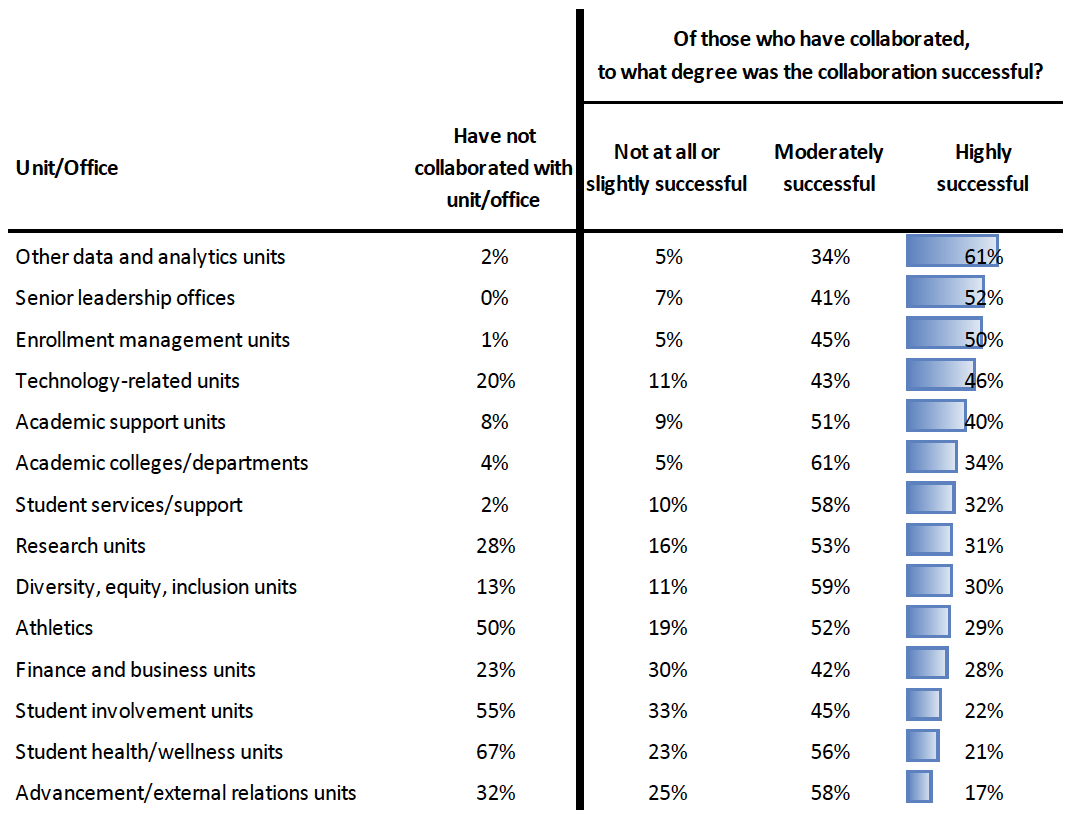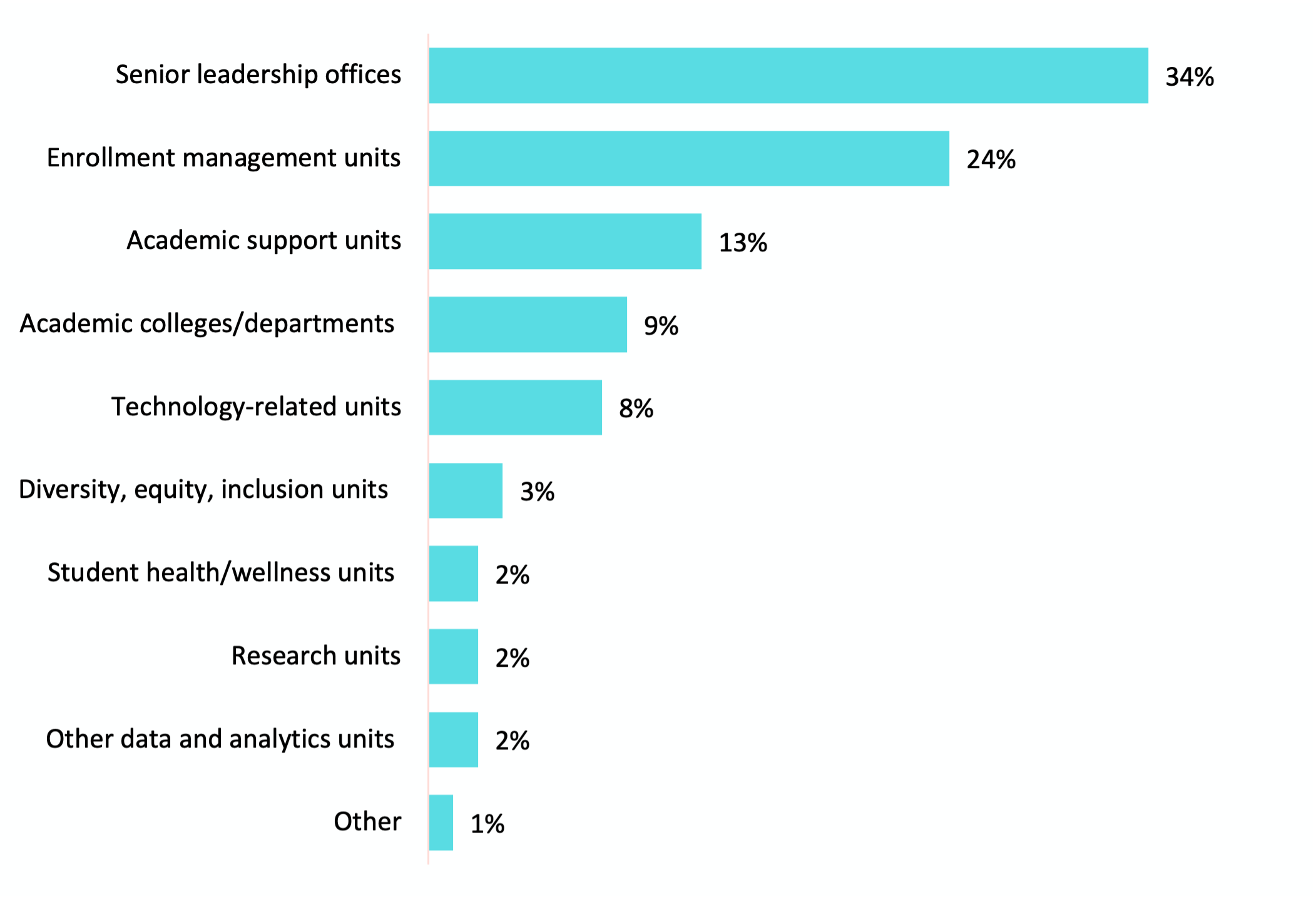Released November 2023
The Association for Institutional Research (AIR) conducted a random survey of U.S. post-secondary institutions to explore how the IR/IE office collaborates with other units/offices in support of student success. The survey launched July 14, 2023, and closed on August 14, 2023; 86 respondents participated in the survey.
We asked survey respondents to evaluate the success of student success collaborations with different units/offices within the past three years (measured on a 4-point Likert scale). We found that the highest percentage of respondents (61%) indicated that collaborations with data and analytics units were highly successful, while the second largest percentage of respondents (52%) responded that collaborations with senior leadership were highly successful (Table 1).
Table 1. Thinking about the past three years, to what degree have collaborations with the following units/offices been successful in support of student success?

From that list of units/offices, we asked survey respondents to indicate which unit/office had the most successful collaborations with their IR/IE office in the past three years in support of student success. 34% of respondents indicated senior leadership offices, while 24% indicated enrollment management units (Chart 1).
Chart 1. Units/Offices with Most Successful Student Success IR/IE Office Collaborations in Past Three Years

We asked respondents to give us examples of student success collaborations and the outcomes of those collaborations; below are examples of those projects:
| Thinking about the unit you selected above, briefly describe a successful student success collaboration. | What was the outcome of that collaboration? |
|---|---|
| We worked with IT to gain access to daily table refreshes, leading to our first project involving a daily update of point-in-time data comparisons of enrollment. | An increased knowledge of the university's enrollment trends compared to the same points in time in previous years. |
| I selected Senior leadership offices as the most successful as our Provost has invested in our IR/IE office including adding staff and providing Professional Development funding for the growing staff. Moreover, as the leader of IR/IE, I am a Vice Provost and meet regularly with the provost. I believe this connection to senior leadership is pivotal for us to identify challenges to student success and we have credibility in IR/IE to work with the other units on campus for improvement. | As new interventions come along, we work with the various offices to benchmark outcomes before intervention. We perform analysis after implementation to measure the effects of the intervention. Recently we worked with the Office of Undergraduate Education to explore the impact of an intervention on first fall term GPA targeting students at risk (e.g., low High School GPA, low standardized test scores, Pell eligible, First-Generation). Extra efforts were made for a set of randomly selected students invited to receive treatment. |
| Developed and implemented a risk factors model used to identify incoming new students who are more at risk for attrition. | Created metric to identify students at risk and used that metric to evaluate programs and processes across campus (e.g., advising, mentorship, campus involvement, financial aid). |
| Creating better recruiting reports, enrollment prediction models, application funnel reports. | Improved application rates, improved application yields. Creation of a 'New Student Welcome Center' which took over events such as Preview Days, campus tours, college fair presentations, New Student Orientation, etc. from the Admissions Office. |
| Coordination and management of the end-to-end student lifecycle on campus, including identifying and assisting with early intervention campaigns; non-retained student outreach; optimizing first-year student placement in math and science courses; and creation/measurement of supplemental math and science support courses. | Improved retention and persistence rates; improved DFW rates for key courses; and a slow drip of long-standing non-retained students returning to complete their degrees. |
| Our Center collaborates regularly with staff from the Provost's Office and the President on data about point-in-time enrollment and term-to-term retention. Data are shared with the Colleges so they can follow up with students about the importance of continued enrollment to successfully earn a degree and determine if additional resources may be needed. | Improved term-to-term retention. |
| Our team is able to raise awareness of the potential imbalance of associate to student race/ethnicity, and encourage hiring managers to recognize the importance of students seeing images of themselves in their academic pursuits. | Increased awareness, hiring plans. |
| The implementation of a new Course Feedback system through the Provost's office (instead of the Registrar's) almost seamlessly integrated internal and external IT teams with the needs and expectations of academic departments and faculty, while considering the data analytics needs of offices like mine, and the high-stakes decision needs of accreditation liaisons and promotion & tenure committees through numerous pre-, during-, and now post-resource launch. | Increased student feedback to faculty about their learning experiences (from a greater quantitative as well as qualitative open-ended responses), along with a new dashboard that gave faculty much more insight (beyond averages) into the responses, and helped department chairs work with faculty noted as lagging in certain metrics, while recognizing and rewarding those consistently deemed exceptional by students, and providing rich discussion points at faculty and pedagogical/teaching resource discussions. |
| The most successful collaboration has been with our Student Success and Well-being division, along with the college Deans and advising offices. Our goal has been to put student-level detail into the hands of the advisors, while providing executive summaries to leadership. | The data availability and accountability has encouraged multiple new student success campaigns and interventions. Retention rates have increased +6 percentage points (to 93%) in the last ten years. 4-year Graduation rates have improved +14 points to 55% (first-time in college cohort). 6-year Graduation rates have improved +11 points to 76%. |
| Tracking re-enrollment at program level - transparency of data and expectations for accountability are the hallmarks of this initiative to facilitate re-enrollment of our students earlier than historic patterns. IR/IE provides a combination of data files and summary reports that identify student re-enrollment and factors that maybe preventing them from re-enrolling including advising and business office holds, academic success indictors, financial information. | The re-enrollment of students exceeded the rates at the same point of time in the enrollment cycle by 10 percentage points. Future analysis will be undertaken to determine if enrolling earlier has an impact on student success and progression. |
Next, we asked the respondents about the significance of IR/IE office collaborations with other units in support of student success. We found that 99% agreed that IR/IE collaborations across the institution play a vital role in improving student success and 98% believed that these collaborations improve data literacy of other units (Chart 2).
Chart 2. Importance of IR/IE Office Collaborations

We also asked respondents about their senior leadership’s role in collaboration. We found that 95% of respondents agreed that their senior leaders encouraged collaboration between units in support of student success and 85% agreed that senior leaders modeled collaboration for their institution (Chart 3).
Chart 3. Senior Leadership Collaboration

When asked how collaborations between IR/IE office and other offices can be more successful in the future, respondents note that streamlining efforts would be beneficial. Below are representative comments from respondents:
- “Encouraging the full feedback loop - from analysis, to insights, to new initiatives, to ROI assessment, to enhanced analysis. Not only will this help identify the most valuable interventions, but also encourage continuous improvement.”
- “We plan a data literacy program and improved communication of results/work-sharing across campus, especially with academic units and auxiliaries, together with a greater focus on data governance and consistency.”
- “Creating time and space for sharing relevant data with other offices/units in a way that stimulated discussion and dialogue.”
- “We need to provide more data literacy workshops for other offices/units on campus.”
- “We still have work to improve our data literacy and analytic maturity on campus, in order to identify the more impactful areas that are affecting student success. Once we can identify key issues, then we can enact changes to target those issues, and monitor.”
- “This is a continuing improvement process. Certainly, there are silos which are entrenched in the ethos of this college, to break the silos will take continuous conversations amongst senior leaders and ground staff. I believe in building relationships and partnerships to foster successful collaboration which means data literacy, transparency and immediacy will be linchpin items for collaboration.”
- “Getting data downstream to individuals who are able to take appropriate action with the data and information and not just keeping it at the higher levels would allow us to be proactive in assisting students.”
About
AIR conducts surveys community surveys on a variety of topics to gather in-the-moment understanding from data professionals working in higher education.
Image Description
Table 1.
Table 1. Thinking about the past three years, to what degree have collaborations with the following units/offices been successful in support of student success?
| Have not collaborated with unit/office | Not at all or slightly successful | Moderately successful | Highly successful | |
|---|---|---|---|---|
| Other data and analytics units | 2% | 5% | 34% | 61% |
| Senior leadership offices | 0% | 7% | 41% | 52% |
| Enrollment management units | 1% | 5% | 45% | 50% |
| Technology-related units | 20% | 11% | 43% | 46% |
| Academic support units | 8% | 9% | 51% | 40% |
| Academic colleges/departments | 4% | 5% | 61% | 34% |
| Student services/support | 2% | 10% | 58% | 32% |
| Research units | 28% | 16% | 53% | 31% |
| Diversity, equity, inclusion units | 13% | 11% | 59% | 30% |
| Athletics | 50% | 19% | 52% | 29% |
| Finance and business units | 23% | 30% | 42% | 28% |
| Student involvement units | 55% | 33% | 45% | 22% |
| Student health/wellness units | 67% | 23% | 56% | 21% |
| Advancement/external relations units | 32% | 25% | 58% | 17% |
Chart 1.
Chart 1. Units/Offices with Most Successful Student Success IR/IE Office Collaborations in Past Three Years
| Unit/Office | % Resp |
|---|---|
| Senior leadership offices | 34% |
| Enrollment management units | 24% |
| Academic support units | 13% |
| Academic colleges/departments | 9% |
| Technology-related units | 8% |
| Diversity, equity, inclusion units | 3% |
| Other data and analytics units | 2% |
| Research units | 2% |
| Student health/wellness units | 2% |
| Other | 1% |
Chart 2
Chart 2. Importance of IR/IE Office Collaborations
| Statement | Strongly/Moderately Disagree | Neutral | Strongly/Moderately Agree |
|---|---|---|---|
| IR/IE office collaborations across the institution are vital in improving student success. | 1% | 4% | 99% |
| IR/IE office collaborations with other offices/units improve their data literacy. | 2% | 5% | 98% |
Chart 3
Chart 3. Senior Leadership Collaboration
| Statement | Strongly/Moderately Disagree | Neutral | Strongly/Moderately Agree |
|---|---|---|---|
| Senior leadership encourages collaboration between units in support of student success. | 5% | 6% | 95% |
| Senior leadership models collaboration for the institution. | 15% | 10% | 85% |
